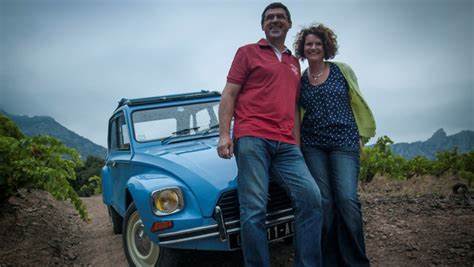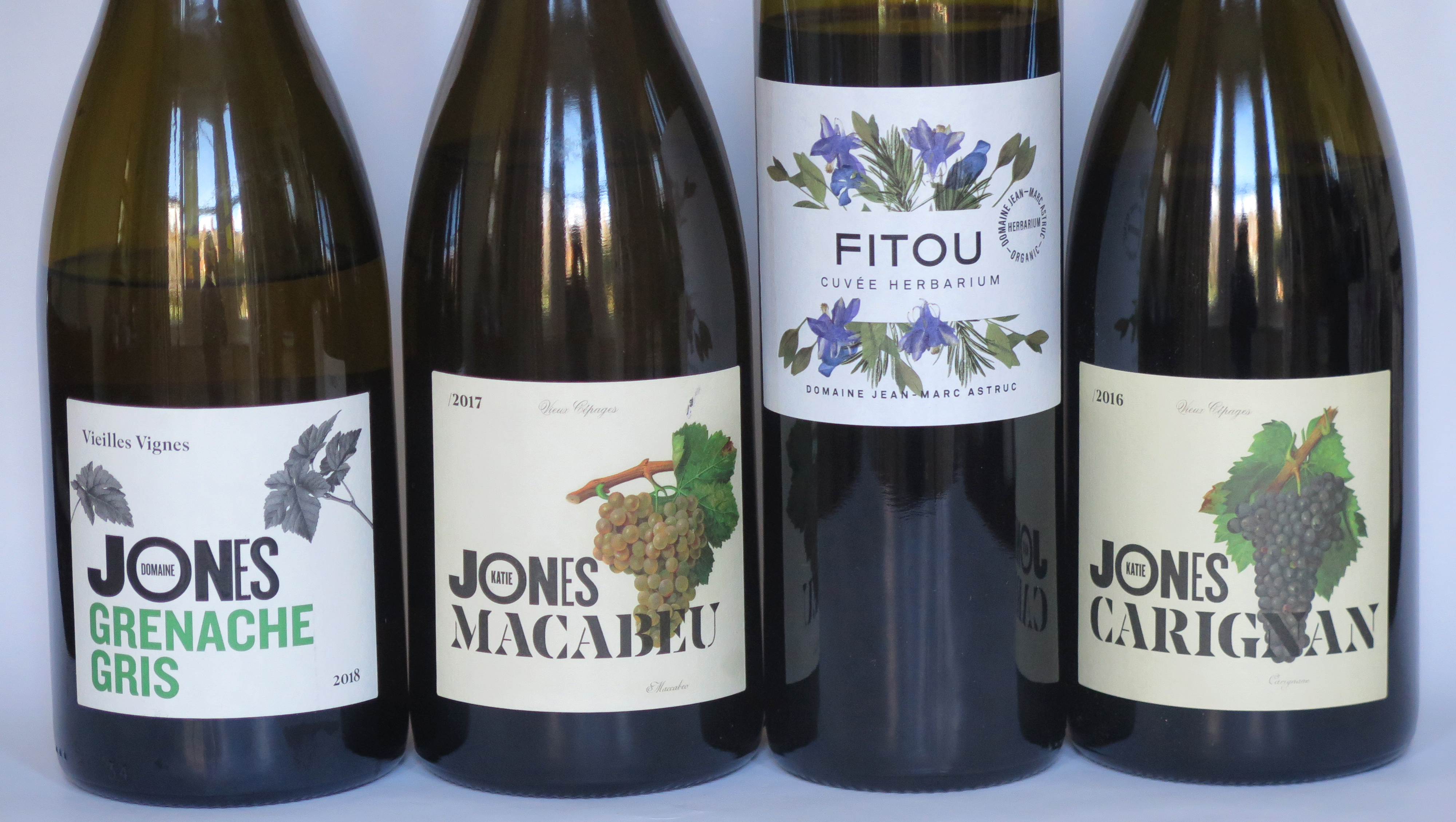 It was another virtual tasting. Yet the warmth of Katie Jones’ personality shone through a night of old vines, human stories of love and struggle … and some great wines.
It was another virtual tasting. Yet the warmth of Katie Jones’ personality shone through a night of old vines, human stories of love and struggle … and some great wines.
Talking to us from her ‘Station winery’ in the village of Tuchan on the Languedoc Roussillon border, Katie started her story with her 926 mile drive from Ashby-de-la-Zouch to Tuchan – think wild boar, hunters’ bullet holes in the road signs, rugby and wine to get the feel for the locality. There she began a fifteen year stint developing the international sales of the dynamic local co-op run by her now-husband Jean-Marc Astruc.
Over a preliminary glass of Grenache Gris, she recounted how the first of her vineyards was really bought for her parents, keen gardeners who wanted something to occupy themselves whilst visiting her in France. After looking ‘high and low’ she found the perfect site, a plot of 80 year old vines. Around the village, old vines are unpopular. Yields are low, the work is back-breaking. Modern equipment doesn’t fit between the rows so she needs (and has) 50 year old ‘tractors’ supplemented by sweat and strimmers to keep down the weeds which deprive the vines of much-needed water. This is a very dry area – less than 500 mm of rain per year and though the plentiful sun and wind make for healthy vines, Katie’s commitment to organic farming demands constant observation and constant work.
The Grenache Gris is very rare mutation of Grenache (normally found in red and white varieties). This was concentrated, complex and delicious – particularly as it warmed towards room temperature – with a lemon meringue pie nose and hints of orange peel on the nose and a honeyed freshness in the mouth.
As Katie admitted, she knew nothing of the vineyard side of wine when she started building up her patchwork of tiny, unregarded sites. Some she bought, some she got for free! But now she has 15 ‘parcelles’ of vines across the district. All are old vines, up to 110 years in some cases, which means just one bottle of wine produced by every vine.
A very different world to the Co-op where she (the ‘golden girl’) was highly successful in selling robust, good quality wines in high quantities to big supermarket chains. But in 2009 she quit her job to make her own ‘very special’ wines. That first harvest brought silver and gold medals from Decanter the IWC and 90+ ratings from Robert Parker. Jealous, perhaps, at her quitting the Co-op, there was a local campaign of harassment aimed at sabotaging her winery. That first year, the tanks were emptied. There are still people iin the village who look the other way when they meet her, still there are lower level problems such as her well being blocked and signage defaced. But, as she said, she has now built up a permanent and enthusiastic workforce that includes supportive locals.
Wine number two was the Les Perles Maccabeu. Historically, this was merely a component of Rives-Saltes VDN, a style of wine that has lost popularity over the years. Maccabeu vines were uprooted and replaced with higher-yielding reds and this is perhaps the last vineyard in the area with this variety. Again she lowered the yield (that one vine one bottle metric again) and now produces a wine marked by warm spice, ripe pears and a rich, almost oily, texture. Some members reported Riesling-like petrol notes, others a kinship with Viognier. Less acidity than the Grenache Gris but clearly an excellent food wine – think avocado salad, prawns and mayo, pan fried scallops. Yes!
Members noted the ripeness of the fruit in the wines and Katie was asked about the impact of climate change. It’s meant earlier harvests for a start – and higher alcohol. Jean-Marc’s father, Members commented on the ripeness of the fruit in Katie’s wines and asked about the impact of climate change. Answering, the referred to the records that Jean-Marc’s father, Roger, also a vigneron. kept of harvest dates over the years. In the past some grapes could be picked in October and vinify at 12.5%. No chance of that now when mid-August harvests and 14-15% alcohol are the norm.
Katie vinifies all her parcels of grapes separately – however small the quantity. That means a wide range of wines of which we could only taste a few. If you fancy exploring the range then you can either opt to visit Katie in Tuchan, where she and Jean-Marc are developing wine tourism or you can check out the excellent selection stocked by the Oxford Wine Company to whom we owe great thanks. They not only gave us a very good price for those bought by members in advance of the tasting but also a substantial discount on follow-up orders. One wine that we weren’t able to try but comes very highly recommended is the ‘Hairy Grenache’ (Lliudoner Pelat if you want to be formal). Well worth trying!
The third wine we tried was her husband’s Fitou ‘Herbarium’, bought from Vinceremos in Leeds. For many years Fitou (a style rather than a grape) has been a high volume, easy drinking wine. His wine, a blend of Syrah and Carignan with a dash of Grenache, whilst still very approachable and very drinkable, was structured, supple and gorgeous. The label [picture??] reflects the ‘garrigue’, that herb- and black fruit filled terroir of southern French hills. Blackberries, figs, thyme and rosemary, olives and balsamic vinegar said some members. Bring on the wild boar stew said others – though none were currently reported as roaming the Banbury or Botley Road terroirs…
Like Katie’s Les Perles Carignan (the last wine of the night) the Fitou improved after opening, keeping their its freshness for a day or more. The Domaine Jones Carignan is a wine for laying down; the Fitou made for drinking younger. The Carignan comes from two small vineyards with centenarian vines. More concentrated than the Fitou but by no means an ‘exhausting’ wine – as one member neatly put it. Both were pretty high in alcohol - -but both were beautifully balanced. Our congratulations to both winemakers.
Members crowded Katie with questions which she hung on patiently to answer for long after our planned closing time. Who’s the boss at Domaine Jones. Well, said Katie, Jean-Marc is the boss when it comes to the vineyards; she rules the roost when it’s sales or marketing. Though they work together on winemaking, each has their own winery. What’s the future for her old vines? Would she replant? Yes, they replace dead vines but there are no forced ejections from her self-described ‘retirement home for old vines’. What about other varieties? Well, there’s just not enough water for such cepages as Cab Sauv or Merlot. And Brexit? She reckons they’ll get over the big distribution problems but sending samples is far more expensive and time-consuming that it was and, for the moment, there’s no mail order to the UK. So … visit the OWC or take a trip when lockdown allows to Tuchan and bring back a boot load – even if you’ll now have to pay the duty.
C’est la vie! But a great evening. We were delighted to meet Jean-Marc, who put in a cameo appearance, but the evening belonged to Katie. Thank you!.
GH: 26/2/21